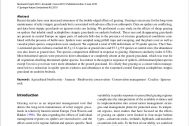Content
Recent decades have seen increased awareness of the double-edged effects of grazing. Grazing is necessary for the long-term maintenance of relict steppic grasslands but is associated with adverse effects on arthropods. Data on spiders are conflicting, and data from steppic grasslands on igneous rocks are lacking. We performed a case study on the effects of sheep grazing on spiders that inhabit small acidophilous steppic grasslands on andesite bedrock. These rare and disappearing grasslands are present in central Europe on upper parts of andesite hills due to the presence of extreme geophysical conditions combined with the pressure of herbivores. Spiders were sampled using pitfall traps and sweeping, and the plant cover as well as vascular plant species composition were analyzed. We captured a total of 689 individuals of 79 spider species. The Chao-1-estimated species richness reached 46.5 ± 11.6 species at grazed sites and 93.7 ± 9.9 species at control sites
the abundance was also lower at grazed sites. The species composition differed in response to grazing (Sørensen similarity index 0.528). Most threatened species were present in lower abundance or completely absent at the grazed grassland, which was true for all vegetation-dwelling threatened spider species. In contrast to the negative response of spiders, all threatened plant species except Veronica prostrata were more abundant at the grazed grassland. It is likely that grazing as a conservation manage-
ment led to a reduction in spider species richness and abundance at the examined central European acidophilous steppic grassland on andesite bedrock.
the abundance was also lower at grazed sites. The species composition differed in response to grazing (Sørensen similarity index 0.528). Most threatened species were present in lower abundance or completely absent at the grazed grassland, which was true for all vegetation-dwelling threatened spider species. In contrast to the negative response of spiders, all threatened plant species except Veronica prostrata were more abundant at the grazed grassland. It is likely that grazing as a conservation manage-
ment led to a reduction in spider species richness and abundance at the examined central European acidophilous steppic grassland on andesite bedrock.



